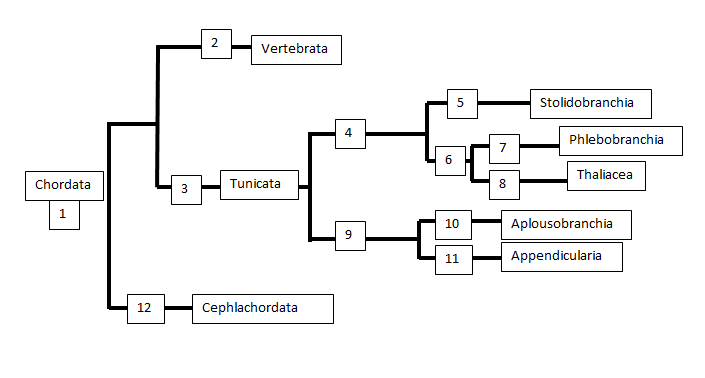Evolution & Systematics
The chordate phylum comprsises of three sub-phyla, the vertebrates, the cephlachodates and the tunicates of which acsidians belong to. Until recently it was thought that the closest relatives to the vertebrates were cephlachordates, with tunicates being the first chordate lineage. This was based upon morphological characteristics along with an apparently increased complexity being found within the cephlachordates comparative to tunicates. However, with the advance of genome sequencing it has been found that the tunicates are more closely related to the vertebrates (Delsuc et al., 2006).
Ascidians were first placed in the tunicata by Lamarck in 1816, although it was thought that this group made up part of the mollusca phyla (Kott, 2005). A study of their larvae in 1866, by Kowalewsky, found shared characteristics of ascidian larvae and chordates, including the axial notochord dorsal neural tube and lateral muscular tail bands (Harrison and Ruppert, 1997). This discovery then placed tunicates in the chordate phylum (Kott, 2005). The tunicates are currently divided into three classes (Herdman, 1882): Ascidiacea, Thaliacea and Appendicularia.
E.diaphanis are part of the Ascidiacea class, which was divided into three orders by Lahille in 1886: Aplousobranchia, Phlebobranchia (Enterogona) and Stolidobranchia (Pleurogona) (Shenkar et al.,2012). E. diaphanis were placed in the phlebobranchia due to the presence of distinct papillae, longitudinal pharyngeal basket vessels and unpaired gonads located anteriorly to the gut loop.
Within the ascidiacea, E. diaphanis belong to the Perophoridae family. A family comprised of eight species found within Australian waters.

|
|
Phylogenetic tree showing the positions of tunicate families within the chordate phylum. Based on and adapted from Ruppert et al. (2004) and Delsuc et al. (2006).
|
1. Chordata: Presence of a hollow notochord at some point in their life cycle, bilateral symmetry, segmention present in the body and muscles, well developed coelom, hemal system and digestive system.
2. Vertebrata: Multi-layered epithelia, blood vessels have endothelia, haemoglobin containing hemocytes, presence of kidneys.
3. Tunicata: Presence of a tunic, reversed heartbeat, Loss of the nephridia and coelom. Mostly hermaphroditic, gonads in the gut loop, determinate development.
4. Longitudinal branchial blood vessels.
5. Stolodobranchia: pleated pharynx lining, neural gland located dorsally to cerebral ganglion, single atrial invagination during developmental.
6. Papillae associated with longitudinal branchial vessels.
7. Phlebobranchia: longitudinal pharyngeal basket vessels.
8. Thaliacea: Reduced larvae, budding arising from the epicardial sac at the posterior end of the endostyle.
9. Horizontal tail (90° rotation to the left), early differentiation of the larvae into a tadpole form, larvae papillae align in the mid-sagittal axis.
10. Aplousobranchia: Zooid body plan is divided into two or three regions, gonads located in the abdomen or post abdomen.
11. Appendicularia: Filter-feeding house made of mucous, sexually mature tadpole, loss of ancestral adult.
12. Cephalochordata: muscular notochord, notochord extends to the anterior extremity of the body (rostrum), presence of myoglobin, asymmetric planktotrophic larvae.
|